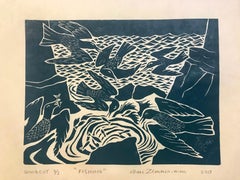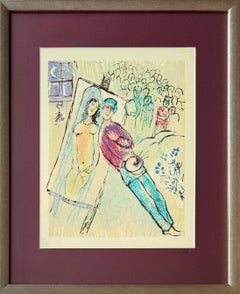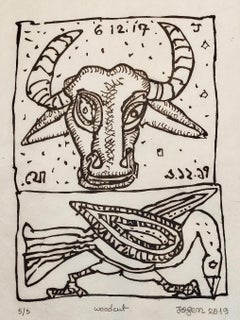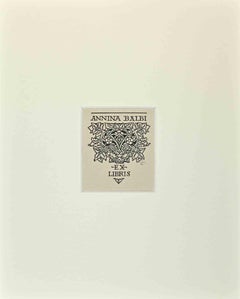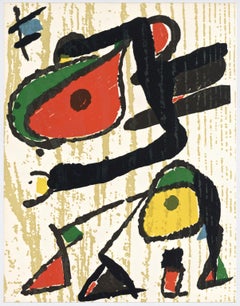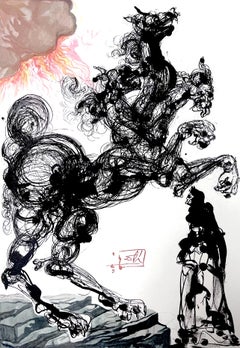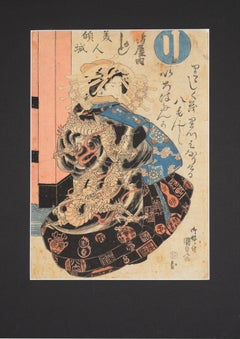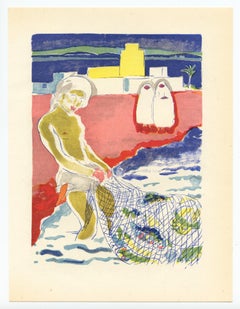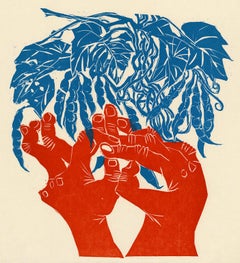Art by Medium: Woodcut
to
885
3,782
523
337
174
296
Overall Width
to
Overall Height
to
41
743
3,690
644
27
108
370
304
160
224
582
267
157
112
22
2,376
620
552
214
206
112
52
41
29
22
4
3
3,649
1,324
116
2,572
1,400
923
918
638
586
528
499
398
371
361
273
242
223
210
192
181
146
144
125
5,119
179,671
94,697
81,444
77,001
286
170
151
58
49
435
2,274
2,231
2,154
Medium: Woodcut
original woodcut
By Joan Miró
Located in Henderson, NV
Medium: original color woodcut. Reference: Dupin 1293. Published for the Jacques Dupin catalogue raisonne "Miro Graveur III" in 1992. Sheet size: 12 1/2 x 9 3/4 inches (320 x 248 mm)...
Category
1990s Abstract Art by Medium: Woodcut
Materials
Woodcut
L'Enfer XIX (Field 189-200; M/L 1039-1138), La Divine Comédie
Located in Auburn Hills, MI
Woodcut in colors on vélin pur chiffon de Rives paper. Paper size: 13 x 10.375 inches. Inscription: Unsigned and unnumbered, as issued. Catalogue raisonné reference: Michler & Löpsin...
Category
1960s Surrealist Art by Medium: Woodcut
Materials
Woodcut
Hölle VI (Field 189-200; M/L 1039-1138), Die Göttliche Komödie
Located in Auburn Hills, MI
Woodcut in colors on vélin de Rives BFK paper, mounted on vélin d’Arches support, as issued. Paper size: 13 x 10.375 inches. Inscription: Signed in the block, and unnumbered, as issu...
Category
1970s Surrealist Art by Medium: Woodcut
Materials
Woodcut
The Courtesan Kashiwagi and the Kamuro Wakano - Japanese Woodblock Print
Located in Soquel, CA
The Courtesan Kashiwagi and the Kamuro Wakano - Japanese Woodblock Print
Original Toyokuni III/Kunisada (Japanese, 1786 - 1864) Japanese Woodblock Print
"The Courtesan Kashiwagi and...
Category
1820s Realist Art by Medium: Woodcut
Materials
Printer's Ink, Rice Paper, Woodcut
wood engraving for Mille Nuits
Located in Henderson, NV
Medium: wood engraving (after the watercolor). Printed in Paris in 1955 at the atelier Coulouma for "Mille nuits et une nuit" (1001 Nights) which was the last major portfolio by Kees...
Category
1950s Art by Medium: Woodcut
Materials
Engraving, Woodcut
'Drop of Life' — from 'Solitude' for Henry David Thoreau's 'Walden'
Located in Myrtle Beach, SC
Naoko Matsubara, 'Drop of Life' for the portfolio 'Solitude', color woodcut, 1971. A fine impression with fresh, vivid colors, on cream laid Japan paper, the full sheet with margins,...
Category
1970s Modern Art by Medium: Woodcut
Materials
Woodcut
Shunga - Woodcut attr. Keisai Eisen - Mid-19th Century
By Keisai Eisen
Located in Roma, IT
Woodcut shunga print attributed to Keisai Eisen and realized in the early 19th century.
Good condition except for some signs of time.
Category
Mid-19th Century Modern Art by Medium: Woodcut
Materials
Woodcut
The Queen's Croquet Ground, from Alice in Wonderland
Located in Washington, DC
Artist: Salvador Dali
Medium: Heliogravure
Title: The Queen's Croquet Ground
Portfolio: 1969 Alice in Wonderland
Year: 1969
Edition: 2430/2500
Frame Size: 24 1/4" x 19 1/2"
Sheet Siz...
Category
1960s Art by Medium: Woodcut
Materials
Woodcut
LAKE TAHOE - One of Gearhart's Most Sought after Block Prints
Located in Santa Monica, CA
FRANCES H. GEARHART (1869-1958)
LAKE TAHOE c. 1933
Color block print, signed and titled in pencil on her typical fibrous Japan paper 10 7/8 x 12”. Full sheet 12 ¾ x 14 3/8” with t...
Category
1930s American Impressionist Art by Medium: Woodcut
Materials
Woodcut
"Early Summer Horse Fair" from 53 Stations of the Tokaido
Located in Soquel, CA
"Early Summer Horse Fair" from 53 Stations of the Tokaido
Woodblock print of a group of horses, originally by Hiroshige (Ando) Utagawa (Japanese, 1797 - 1858). Several groups of hor...
Category
1830s Edo Art by Medium: Woodcut
Materials
Rice Paper, Woodcut
Persephone (Blue)
Located in New York, NY
edition 21/35
Published by Durham Press
In her sculpture, wall hangings, and prints, Apfelbaum explores complex formal and chromatic relationships, pushing the canon of modernist ab...
Category
2010s Pop Art Art by Medium: Woodcut
Materials
Woodcut
Divine Comedy : Hell 12, The Minotaure - Woodcut - 1963 (Field #p. 189)
Located in Paris, IDF
Salvador Dali (1904-1989)
Hell 12 - The Minotaure
Woodcut
Printed signature in the plate 1960/63
Printed on paper Vélin BFK Rives
Size 32,8 x 26,4 cm (c. 13 x 10")
REFERENCES : Fie...
Category
1960s Modern Art by Medium: Woodcut
Materials
Woodcut
'Snow Shovellers, New York' — American Modernism
Located in Myrtle Beach, SC
Clare Leighton, 'Snow Shovellers, New York', 1929, wood engraving, edition 45, Boston Public Library 146. Signed, titled, and numbered '29/45' in pencil. A...
Category
1920s American Modern Art by Medium: Woodcut
Materials
Woodcut
Dueling with Cherry Blossoms - Tales of Genji - Japanese Woodblock
Located in Soquel, CA
Dueling with Cherry Blossoms - Tales of Genji - Japanese Woodblock
Rightmost panel a triptych, depicting a group of children and a samurai watching a "duel" with cherry blossoms. Th...
Category
1850s Realist Art by Medium: Woodcut
Materials
Printer's Ink, Rice Paper, Woodcut
'Taos Placita' — American Southwest Regionalist Masterwork
Located in Myrtle Beach, SC
Gustave Baumann, 'Taos Placita', color woodcut, 1947, edition 125. Baumann 132. Signed, titled, and numbered '20-125' in pencil; with the artist’s Hand-in-Heart chop. A superb, richly-inked impression, with fresh colors, on fibrous oatmeal wove paper; the full sheet with margins (2 to 3 1/8 inches); slight rippling at the left sheet edge, in excellent condition. Matted to museum standards, unframed.
Image size 9 5/8 x 11 1/4 inches (244 x 286 mm); sheet size 13 1/4 x 17 inches (337 x 432 mm).
Collections: New Mexico Museum of Art, Phoenix Art Museum, Wichita Art Museum.
ABOUT THE ARTIST
Gustave Baumann (1881-1971) was a renowned printmaker and a leading figure of the American color woodcut revival whose exquisite craftsmanship and vibrant imagery captured the essence of the Southwest.
"A brilliant printmaker, Baumann brought to the medium a full mastery of the craft of woodworking that he acquired from his father, a German cabinetmaker. This craftsmanship was coupled with a strong artistic training that resulted in the handsome objects we see in the exhibition today. After discovering New Mexico in 1918, Baumann began to explore in his woodblock prints of this period the light. color, and architectural forms of that landscape. His prints of this period are among the most beautiful and poetic images of the American West."
—Lewis I. Sharp, Director, Denver Art Museum
Baumann, the son of a craftsman, immigrated to the United States from Germany with his family when he was ten, settling in Chicago. From 1897 to 1904, he studied in the evenings at the Art Institute of Chicago, working in a commercial printmaking shop during the day. In 1905, he returned to Germany to attend the Kunstwerbe Schule in Munich, where he decided on a career in printmaking. He returned to Chicago in 1906 and worked for a few years as a graphic designer of labels.
Baumann made his first prints in 1909 and exhibited them at the Art Institute of Chicago the following year. In 1910, he moved to the artists’ colony in Nashville, Indiana, where he explored the creative and commercial possibilities of a career as a printmaker. In 1915, he exhibited his color woodcuts at the Panama-Pacific International Exposition in San Francisco, winning the gold medal.
Among Baumann’s ongoing commercial activities was his work for the Packard Motor Car Company from 1914 to 1920 where he produced designs, illustrations, and color woodcuts until 1923.
In 1919, Baumann’s printmaking work dominated the important exhibition of American color woodcuts at the Detroit Institute of Arts. Twenty-six of his prints were included, far more than the works of any other artist. A set of his blocks, a preparatory drawing, and seven progressive proofs complemented the exhibition. That same year, Baumann worked in New York and, over the summer, in Provincetown, Massachusetts. His airy images of Cape Cod employed soft, pastel colors and occasionally showed the influence of the white-line woodcut technique.
Many of his Chicago artist friends had traveled to the southwest, and Baumann became intrigued by their paintings, souvenirs, and stories of an exotic place named Taos, New Mexico. In the summer of 1918, he spent the summer in Taos sketching and painting before visiting Santa Fe. Paul Walter, the director of the Museum of New Mexico, offered him a studio in the museum's basement. Inspired by the rugged beauty of the Southwest—the vibrant colors and dramatic landscapes of the region became a central theme in his work, influencing his artistic style and subject matter for the remainder of his career. Later in the decade, he traveled to the West Coast and made prints of California landscape.
Baumann's prints became synonymous with the Southwest, capturing the spirit of its place in America's identity with a unique sense of authenticity and reverence. His iconic images of desert vistas, pueblo villages, and indigenous cultures served as visual tributes to the region's rich cultural heritage, earning him a dedicated following among collectors and curators alike.
A true craftsman and artist, Baumann completed every step of the printmaking process himself, cutting each block, mixing the inks, and printing every impression on the handmade paper he selected. His dedication to true craftsmanship and his commitment to preserving the integrity of his artistic vision earned him widespread acclaim and recognition within the art world. About the vibrant colors he produced, Baumann stated, “A knowledge of color needs to be acquired since they don’t all behave the same way when ground or mixed...careful chemistry goes into the making of colors, with meticulous testing for permanence. While complicated formulae evolve new colors, those derived from Earth and metal bases are still the most reliable.”
In the 1930s, Baumann became interested in puppet theater. He designed and carved his own marionettes and established a little traveling company. From 1943 to 1945, the artist carved an altarpiece for the Episcopal Church of the Holy Faith in Santa Fe. In 1952, a retrospective exhibition of his prints was mounted at the New Mexico Museum of Fine Arts. Throughout his prolific career, Baumann executed nearly four hundred color woodcuts.
Baumann’s woodcuts...
Category
1940s American Modern Art by Medium: Woodcut
Materials
Woodcut
Sanjûroku Kasen ... - Woodcut by Mizuno Toshikata - 1893
Located in Roma, IT
Nishiki-e (woodcut print), in vertical oban format (31x20.5) realized by Mizuno Toshikata in 1893 (Meiji 26).
Belongs to the Series "Sanjûroku Kasen" (Thirty-Six Beauties in Compari...
Category
1890s Modern Art by Medium: Woodcut
Materials
Woodcut
'Rain at Shinagawa, Ryoshimachi' — lifetime impression
By Kawase Hasui
Located in Myrtle Beach, SC
A fine, atmospheric impression, with fresh colors; the full sheet, in excellent condition. Signed 'Hasui' with the artist’s seal 'Kawase', lower left. Published by Watanabe Shozaburo with the Watanabe 6mm round seal indicating a lifetime impression printed between 1945 - 1957. Archivally sleeved, unmatted.
Image size 14 1/4 x 9 3/8 inches (362 x 238 mm); sheet size 15 1/2 x 10 3/8 inches (391 x 264 mm).
An impression of this work is in the permanent collection of the Fine Arts Museum of San Francisco, Achenbach Foundation.
ABOUT THE ARTIST
“I do not paint subjective impressions. My work is based on reality...I can not falsify...(but) I can simplify…I make mental impressions of the light and color at the time of sketching. While coloring the sketch, I am already imagining the effects in a woodblock print.” — Kawase Hasui
Hasui Kawase (1883–1957) is the most celebrated Japanese print designer of the shin-hanga ('new prints') movement. His prints, produced under the guidance and discerning eye of his publisher, Watanabe Shozaburo, represent the modern legacy of the renowned 19th-century Ukiyo-e masters Hiroshige and Hokusai. Hasui was able to evoke the fleeting beauty of Japan during the interwar period as no other printmaker of his time could.
Hasui's work enjoyed huge popularity upon producing his first print in 1918. Watanabe recognized and developed the enormous potential of the American market, resulting in Hasui's prints achieving high prices at auctions in New York as early as the 1920s. After the Second World War, his prints became highly sought-after collectible works among the American occupying forces in Japan. Hasui designed more than 600 prints during the 40-year span of his artistic career, and in 1956, he was named a 'Living National Treasure' of Japan.
Hasui’s woodblock...
Category
1930s Showa Art by Medium: Woodcut
Materials
Woodcut
STORM LINED - Large Format Gearhart
Located in Santa Monica, CA
FRANCES H. GEARHART (1869-1958)
STORM LINED c.1936
Color block print, signed and titled in pencil 13 ¼ x 10 1/8, full sheet 14 3/8 x 11 ¼” with deckle edge on her typical fibrous Ja...
Category
1930s Abstract Impressionist Art by Medium: Woodcut
Materials
Color, Woodcut
"Portal I", Abstract Patterns, Geometric Abstraction, Woodcut Monoprint on Panel
Located in Philadelphia, PA
This piece titled "Portal I" is an original piece by Alexis Nutini and is made from a woodcut monoprint mounted on panel. This piece measures 14.5"h x 9.5"w.
Born in Mexico City, A...
Category
21st Century and Contemporary Contemporary Art by Medium: Woodcut
Materials
Panel, Monoprint, Woodcut, Paper
wood engraving for Mille Nuits
Located in Henderson, NV
Medium: wood engraving (after the watercolor). Printed in Paris in 1955 at the atelier Coulouma for "Mille nuits et une nuit" (1001 Nights) which was the last major portfolio by Kees...
Category
1950s Art by Medium: Woodcut
Materials
Engraving, Woodcut
'Garyu no sakura' (The Lying Dragon Cherry Tree, Gifu) — Sosaku Hanga Woodblock
Located in Myrtle Beach, SC
Hajime Namiki, 'Garyu no sakura (The Lying Dragon Cherry Tree, Gifu)', color woodcut, 2003, edition 200. Signed in pencil and with the artist’s red seal....
Category
Early 2000s Contemporary Art by Medium: Woodcut
Materials
Woodcut
'Public Building' — American Modernism, WPA
Located in Myrtle Beach, SC
Fred Becker, 'Public Building', wood engraving, c. 1937, edition c. 25. Signed and titled in pencil. A superb, richly-inked impression, on cream wove Japan...
Category
1930s Modern Art by Medium: Woodcut
Materials
Woodcut
Stars/Sterren - Woodcut by Maurits Cornelis Escher - 1948
Located in Roma, IT
Woodcut print realized by Escher in 1948.
Hand signed in pencil and annotated in pencil lower right "eigen druck".
Monogrammed and dated in the plate "MCE/X-'48 upper right.
One o...
Category
1940s Modern Art by Medium: Woodcut
Materials
Woodcut
Chinese Theatrical Mask - Woodcut - Mid-20th Century
Located in Roma, IT
Vintage chinese woodcut print depicting a theatrical mask.
Realized in the mid-20th Century.
Framed under glass.
Category
Mid-20th Century Modern Art by Medium: Woodcut
Materials
Woodcut
Dancers, 1936 Woodcut by Georges Rouault
Located in Long Island City, NY
Dancers
Georges Rouault, French (1871–1958)
Date: 1936
Woodcut, initialed in the stone
Size: 3 x 2 in. (7.62 x 5.08 cm)
Frame Size: 9.5 x 8.25 inches
Category
1930s Expressionist Art by Medium: Woodcut
Materials
Woodcut
Le Paradis IX (Field 189-200; M/L 1039-1138), La Divine Comédie
Located in Auburn Hills, MI
Woodcut in colors on vélin pur chiffon de Rives paper. Paper size: 13 x 10.375 inches. Inscription: Unsigned and unnumbered, as issued. Catalogue raisonné reference: Michler & Löpsin...
Category
1960s Surrealist Art by Medium: Woodcut
Materials
Woodcut
Sean Scully, Standing 2, colored woodcut on handmade paper, signed #14/35 Framed
By Sean Scully
Located in New York, NY
Sean Scully
Standing 2, 1986
Color Woodcut on handmade Okawara paper
Signed, inscribed with title and numbered from the limited edition of only 35 in graphite on the front. Matted an...
Category
1980s Abstract Art by Medium: Woodcut
Materials
Rice Paper, Woodcut
'Starry Night' — 1930s American Modernism
Located in Myrtle Beach, SC
Rockwell Kent, 'Starry Night' wood engraving, 1933, edition 1750, Burne Jones 103. Signed in pencil. A brilliant, black impression, on cream wove Japan paper; with margins (7/8 to 1 ...
Category
1930s American Modern Art by Medium: Woodcut
Materials
Woodcut
Fegefeuer XVII (Field 189-200; M/L 1039-1138), Die Göttliche Komödie
Located in Auburn Hills, MI
Woodcut in colors on vélin de Rives BFK paper, mounted on vélin d’Arches support, as issued. Paper size: 13 x 10.375 inches. Inscription: Signed in the block, and unnumbered, as issu...
Category
1970s Surrealist Art by Medium: Woodcut
Materials
Woodcut
"Portalito", Abstract Patterns, Geometric Abstraction, Woodcut Monoprint
Located in Philadelphia, PA
This piece titled "Portalito" is an original piece by Alexis Nutini and is made from a woodcut monoprint mounted on panel. This piece measures 7.25"h x 9.5"w.
Born in Mexico City, ...
Category
21st Century and Contemporary Contemporary Art by Medium: Woodcut
Materials
Panel, Monoprint, Woodcut
'Simplicius' Farewell to the World' — Graphic Modernism
Located in Myrtle Beach, SC
Fritz Eichenberg, 'Simplicius’ Farewell To The World' from the suite 'The Adventurous Simplicissimus', wood engraving, 1977, artist's proof apart from the edition of 50. Signed in pencil. Signed in the block, lower right. A fine, richly-inked impression, on cream wove paper, with full margins (1 1/2 to 2 inches), in excellent condition. Image size 14 x 12 inches (356 x 305 mm); sheet size 17 1/2 x 15 inches (445 x 381 mm). Archivally sleeved, unmatted.
ABOUT THIS WORK
'Simplicius Simplicissimus' (German: Der abenteuerliche Simplicissimus Teutsch) is a picaresque novel of the lower Baroque style, written in five books by Hans Jakob Christoffel von Grimmelshausen published in 1668, with the sequel Continuatio appearing in 1669.
The novel is told from the perspective of its protagonist Simplicius, a rogue or picaro typical of the picaresque novel, as he traverses the tumultuous world of the Holy Roman Empire during the Thirty Years' War. Raised by a peasant family, he is separated from his home by foraging dragoons. He is adopted by a hermit living in the forest, who teaches him to read and introduces him to religion. The hermit also gives Simplicius his name because he is so simple that he does not know his own name. After the death of the hermit, Simplicius must fend for himself. He is conscripted at a young age into service and, from there, embarks on years of foraging, military triumph, wealth, prostitution, disease, bourgeois domestic life, and travels to Russia, France, and an alternate world inhabited by mermen. The novel ends with Simplicius turning to a life of hermitage, denouncing the world as corrupt.
ABOUT THE ARTIST
Fritz Eichenberg (1901–1990) was a German-American illustrator and arts educator who worked primarily in wood engraving. His best-known works were concerned with religion, social justice, and nonviolence.
Eichenberg was born to a Jewish family in Cologne, Germany, where the destruction of World War I helped to shape his anti-war sentiments. He worked as a printer's apprentice and studied at the Municipal School of Applied Arts in Cologne and the Academy of Graphic Arts in Leipzig, where he studied under Hugo Steiner-Prag. In 1923 he moved to Berlin to begin his career as an artist, producing illustrations for books and newspapers. In his newspaper and magazine work, Eichenberg was politically outspoken and sometimes wrote and illustrated his reporting.
In 1933, the rise of Adolf Hitler drove Eichenberg, who was a public critic of the Nazis, to emigrate with his wife and children to the United States. He settled in New York City, where he lived most of his life. He worked in the WPA Federal Arts Project and was a member of the Society of American Graphic Artists.
In his prolific career as a book illustrator, Eichenberg portrayed many forms of literature but specialized in works with elements of extreme spiritual and emotional conflict, fantasy, or social satire. Over his long career, Eichenberg was commissioned to illustrate more than 100 classics by publishers in the United States and abroad, including works by renowned authors Dostoyevsky, Tolstoy, Charlotte and Emily Brontë, Poe, Swift, and Grimmelshausen. He also wrote and illustrated books of folklore and children's stories.
Eichenberg was a long-time contributor to the progressive magazine The Nation, his illustrations appearing between 1930 and 1980. Eichenberg’s work has been featured by such esteemed publishers as The Heritage Club, Random House, Book of the Month Club, The Limited Editions Club, Kingsport Press, Aquarius Press, and Doubleday.
Raised in a non-religious family, Eichenberg had been attracted to Taoism as a child. Following his wife's unexpected death in 1937, he turned briefly to Zen Buddhist meditation, then joined the Religious Society of Friends in 1940. Though he remained a Quaker until his death, Eichenberg was also associated with Catholic charity work through his friendship with Dorothy Day...
Category
1970s American Modern Art by Medium: Woodcut
Materials
Woodcut
Divine Comedy
Located in OPOLE, PL
Salvador Dalí’s Divine Comedy is a series of 100 color wood engravings, each corresponding to a canto from Dante Alighieri’s epic poem. Created between 1960 and 1964, these engraving...
Category
1970s Surrealist Art by Medium: Woodcut
Materials
Woodcut
'Bullfight'— Mid-century American Surrealism
Located in Myrtle Beach, SC
Robert Vale Faro, 'Bullfight', wood engraving, 1945, edition 15. Signed, dated, titled, and numbered '105' (the artist's inventory number) and '13/15' in pencil. A fine, richly-inked impression, on cream wove paper, with full margins (1 1/16 to 2 3/8 inches), in excellent condition. Scarce. Matted to museum standards, unframed.
Image size 5 1/16 x 4 1/16 inches (129 x 103 mm); sheet size 8 9/16 x 6 5/16 inches (217 x 160 mm).
An impression of this work is included in the museum collection of the National Gallery of Art.
ABOUT THE ARTIST
Robert Vale Faro (1902-1988) was a well-known modernist architect and artist associated with the Chicago Bauhaus. He received his degree in architecture and design from the Armour Institute in Chicago and worked at L'Ecole des Beaux-Arts, Paris, from 1924-27, where he was influenced by Harry Kurt Bieg and Le Corbusier. Upon his return to Chicago, Faro worked with the important modernist Chicago architects George and William Keck under Louis Sullivan.
Faro founded the avant-garde printmaking group Vanguard in 1945. The group counted Atelier 17 artists Stanley William Hayter, Sue Fuller, and Anne Ryan as New York members and Francine Felsenthal...
Category
1940s Surrealist Art by Medium: Woodcut
Materials
Woodcut
'The Spirit of the Wine' — Japanese Legend from the Famed Chikamatsu Series
Located in Myrtle Beach, SC
Hokuto Tamamura (1893-1951), 'The Spirit of the Wine' (Shuten Dōji) - from Dai Chikamatsu Zenshu (The Complete Works of Chikamatsu)', color woodblock, 1923-26. Signed 'Hokuto'. A fin...
Category
1920s Showa Art by Medium: Woodcut
Materials
Woodcut
Clinton Hill, Title Page II, 1956, woodcut, landscape/abstraction
By Clinton Hill
Located in New York, NY
Clinton Hill (1922-2003), lived in SoHo, New York, and was a frequent Gallery visitor. Born in Idaho and raised on a working ranch, he joined the US Navy during World War II and beca...
Category
Mid-20th Century Abstract Art by Medium: Woodcut
Materials
Woodcut
Seishi Ai-oi Genji – Set of 12 Shunga works together w/astrological commentary
Located in Middletown, NY
Set of 12 woodblock prints in colors on handmade, laid mulberry paper, 6 3/4 x 10 1/4 inches (170 x 258 mm), printed in Ka-ei 4 (1851). Each print with minor handling wear, otherwise in excellent condition with bright and fresh color, and with details printed in silver ink. The images themselves contain several illusive characters indicating the publisher which are obfuscated by figures, as intended. Presented loose, as issued. A fine set.
The astrological commentary print has a large and meandering blind stamp with a bird and palm frond motif. This print lists various phrases concerning the Twelve Zodiac Animals as historically counted in Japan, and appears to include erotic commentary on the traits of people born under each of the twelve signs.
These Shunga images were issued in books that paralleled (in an erotic fashion...
Category
Mid-19th Century Edo Art by Medium: Woodcut
Materials
Ink, Handmade Paper, Woodcut
'Laguna Cove' — American Modernism, California
Located in Myrtle Beach, SC
Paul Landacre, 'Laguna Cove', wood engraving, 1935; edition 60 (16 printed), 2nd edition 150 (6 printed), Woodcut Society 200, Wien 247. Signed and titled in pencil. A brilliant, black impression, on cream wove Japan, with full margins (3/4 to 1 3/4 inches), in excellent condition. Archivally matted to museum standards, unframed.
This impression is from the edition published for the Twentieth Presentation Print of the Woodcut Society, 1941. Printed by Torch Press, Cedar Rapids.
Literature: Reproduced in 'James Swann...
Category
1930s American Modern Art by Medium: Woodcut
Materials
Woodcut
"Lendas Africanas Da Bahia" from the suite.
Located in San Francisco, CA
This artwork titled " Lendas Africanas Da Bahia" from the suite, 1978, is an original colors woodcut by renown Brazilian/Argentinian artist Hector Julio Paride Barnabo Carybe, 1911-1997. It is hand signed and numbered 83/200 in pencil by the artist. The Wood block mark (image) is 23.65 x 15.75 inches, sheet size is 26.75 x 19 inches. It is in excellent condition, has never been framed. It will be shipped in a 8 inches diameter heavy duty tube.
About the artist:
Héctor Julio Páride Bernabó (7 February 1911 – 2 October 1997) was an Argentine-Brazilian artist, researcher, writer, historian and journalist. His nickname and artistic name, Carybé, a type of piranha, comes from his time in the scouts. He died of heart failure after the meeting of a candomblé community's lay board of directors, the Cruz Santa Opô Afonjá Society, of which he was a member.
Quick Facts Born, Died ...
Carybé
Born
Héctor Julio Páride Bernabó
7 February 1911
Lanús, Argentina
Died
2 October 1997 (aged 86)
Salvador, Bahia, Brazil
Nationality
Brazilian
Known for
Painter, engraver, draughtsman, illustrator, potter, sculptor, mural painter, researcher, historian and journalist
Close
He produced thousands of works, including paintings, drawings, sculptures and sketches. He was an Obá de Xangô, an honorary position at Ilê Axé Opô Afonjá.
Orixá Panels in the Afro-Brazilian Museum in Salvador
Some of Carybé's work can be found in the Afro-Brazilian Museum in Salvador: 27 cedar panels representing different orixás or divinities of the Afro-Brazilian religion candomblé. Each panel shows a divinity with their associated implements and animal. The work was commissioned by the former Banco da Bahia S.A., now Banco BBM S.A., which originally installed them in its branch on Avenida Sete de Setembro in 1968.
Murals at Miami International Airport
American Airlines, Odebrecht and the Miami-Dade Aviation Department partnered to install two of Carybé's murals at Miami International Airport. They have been displayed in the American Airlines terminal at John F. Kennedy International Airport in New York since 1960. The 16.5 x 53-foot murals were accredited when Carybé won the first and the second prize in a contest of public art pieces for JFK airport.
As its terminal at that airport was due for demolition, American Airlines donated the murals to Miami-Dade County, and Odebrecht invested in a project to remove, restore, transport and install the murals at Miami International Airport.
The mural "Rejoicing and Festival of the Americas" portrays colorful scenes from popular festivals throughout the Americas, and "Discovery and Settlement of the West" depicts the pioneers’ journey into the American West.
Carybé's Woodcuts in Gabriel García Márquez's Books
Carybé illustrated four books by the Colombian writer Gabriel García Márquez, including One Hundred Years of Solitude, The Autumn of the Patriarch, Chronicle of a Death Foretold, and Love in the Time of Cholera "Carybé: um mestre da cultura baiana". ArqBahia Arquitetura, design, arte e lifestyle (in Brazilian Portuguese). 26 April 2023.. In particular, the woodcuts in One Hundred Years of Solitude are well-known for providing a visual image of the fictional town of Macondo, where the story takes place. The illustrations depict the colorful and winding houses, the railway bridge, and the hot and humid climate of the region, contributing to the reader's immersion in the story.
Carybé's woodcuts are, therefore, an important part of Gabriel García Márquez's literary legacy, bringing a visual dimension to his stories that further enriches the reader's experience.
Timeline
1911 — Birth in Lanús, Argentina.
1919 — Moved to Brazil.
1921 — The name Carybé is first given to him by the Clube do Flamengo scouts group, in Rio de Janeiro.
1925 — Beginning of his artistic endeavours, going to the pottery workshop of his elder brother, Arnaldo Bernabó, in Rio de Janeiro.
1927–1929 — Studies at the National School of Fine Arts, in Rio de Janeiro.
1930 — Worked for the newspaper Noticias Gráficas, in Buenos Aires, Argentina.
1935–1936 — Works with the writer Julio Cortázar and as a draughtsman for the El Diario newspaper.
1938 — Sent to Salvador by newspaper Prégon.
1939 — First collective exhibition, with the artist Clemente Moreau, at the Buenos Aires City Museum of Fine Arts, Argentina; illustrates the book Macumba, Relatos de la Tierra Verde, by Bernardo Kardon, published by Tiempo Nuestro.
1940 — Illustrates the book Macunaíma, by Mário de Andrade.
1941 — Draws the Esso Almanach, the payment for which allows him to set on a long journey through Uruguay, Brazil, Bolivia, and Argentina.
1941–1942 — Study trip around several South American countries.
1942 — Illustration for the book La Carreta by Henrique Amorim, published by El Ateneo (Buenos Aires, Argentina).
1943 — Together with Raul Brié, translates the book Macunaíma, by Mário de Andrade, into Spanish; produces the illustrations for the works Maracatu, Motivos Típicos y Carnavalescos, by Newton Freitas, published by Pigmaleon, Luna Muerta, by Manoel Castilla, published by Schapire, and Amores de Juventud, by Casanova Callabero; also publishes and illustrates Me voy al Norte, for the quarterly magazine Libertad Creadora; awarded First Prize by the Cámara Argentina del Libro (Argentine Book Council) for the illustration of the book Juvenília, by Miguel Cané (Buenos Aires, Argentina).
1944 — Illustrates the books The Complete Poetry of Walt Whitmann and A Cabana do Pai Tomás, both published by Schapire ; as well as and Los Quatro Gigantes del Alma by Mira y Lopez, Salvador BA; attends capoeira classes, visits candomblé meetings and makes drawings and paintings.
1945 — Does the illustrations for Daniel Defoe's Robinson Crusoe, for the Viau publishing house.
1946 — Helps in setting up the Tribuna da Imprensa newspaper, in Rio de Janeiro.
1947 — Works for the O Diário Carioca newspaper, in Rio de Janeiro.
1948 — Produces texts and illustrations for the book Ajtuss, Ediciones Botella al Mar (Buenos Aires, Argentina).
1949–1950 — Invited by Carlos Lacerda to work at the Tribuna da Imprensa, in Rio de Janeiro.
1950 — Invited by the Education Secretary Anísio Teixeira, moves to Bahia, and produces two panels for the Carneiro Ribeiro Education Center (Park School), in Salvador, Bahia.
1950–1997 — Settles in Salvador, Bahia.
1950–1960 — Actively participate in the plastic arts renewal movement, alongside Mário Cravo Júnior, Genaro de Carvalho, and Jenner Augusto.
1951 — Produces texts and illustrations for the works of the Coleção Recôncavo, published by Tipografia Beneditina and illustrations for the book, Bahia, Imagens da Terra e do Povo, by Odorico Tavares, published by José Olímpio in Rio de Janeiro; for the latter work he receives the gold medal at the 1st Biennial of Books and Graphic Arts.
1952 — Makes roughly 1,600 drawings for the scenes of the movie O Cangaceiro, by Lima Barreto; also works as the art director and as an extra on the film (São Paulo, SP).
1953 — Illustrations for the book A Borboleta Amarela, by Rubem Braga, published by José Olímpio (Rio de Janeiro, RJ).
1955 — Illustrates the work O Torso da Baiana, edited by the Modern Art Museum of Bahia.
1957 — Produces etchings, with original designs, for the special edition of Mário de Andrade's Macunaíma, published by the Sociedade dos 100 Bibliófilos do Brasil.
1958 — Makes an oil painting mural for the Petrobras Office in New York, USA; illustrates the book As Três Mulheres de Xangô, by Zora Seljan, published by Editora G. R. D. (Rio de Janeiro, RJ); Receives a scholarship grant in New York, USA.
1959 — Takes part in the competition for the New York International Airport panels project, in New York, USA, winning first and second prizes.
1961 — Illustrates the book Jubiabá, by Jorge Amado, published by Martins Fontes (São Paulo, SP).
1963 — Awarded the title of Honorary Citizen of Salvador, Bahia.
1965 — Illustrates A Muito Leal e Heróica Cidade de São Sebastião do Rio de Janeiro, published by Raymundo Castro Maya (Rio de Janeiro, RJ).
1966 — With Jorge Amado, co-authors Bahia, Boa Terra Bahia, published by Image (Rio de Janeiro, RJ); writes and illustrates the book Olha o Boi, published by Cultrix (São Paulo, SP).
1967 — Receives the Odorico Tavares Prize – Best Plastic Artist of 1967, in a competition ran by the state government to stimulate the development of plastic arts in Bahia; makes the Orixás Panels for the Banco da Bahia (currently at the UFBA Afro-Brazilian Museum) (Salvador, BA).
1968 — Illustrates the books Carta de Pero Vaz de Caminha ao Rei Dom Manuel, published by Sabiá (Rio de Janeiro) and Capoeira Angolana, by Waldeloir Rego, published by Itapoã (Bahia).
1969 — Produces the illustrations for the book Ninguém Escreve ao Coronel, by Gabriel Garcia Marquez, published by Sabiá (Rio de Janeiro, RJ).
1970 — Illustrates the books O Enterro do Diabo and Os Funerais de Mamãe Grande, published by Sabiá (Rio de Janeiro, RJ), Agotimé her Legend, by Judith Gleason, published by Grossman Publishers (New York, USA).
1971 — Illustrates the books One Hundred Years of Solitude, by Gabriel Garcia Marquez and A Casa Verde by Mario Vargas Llosa, both published by Sabiá (Rio de Janeiro, RJ); produces texts and illustrations for the book Candomblé da Bahia, published by Brunner (São Paulo, SP).
1973 — Illustrations for Gabriel Garcia Marquez's A Incrível e Triste História de Cândida Erendira e sua Avó Desalmada (Rio de Janeiro, RJ); paints the mural for the Legislative Assembly and the panel for the Bahia State Secretary of the Treasury.
1974 — Produces woodcuts for the book Visitações da Bahia, published by Onile.
1976 — Illustrates the book O Gato Malhado e a Andorinha Sinhá: uma história de amor, by Jorge Amado (Salvador, BA); receives the title of Knight of the Order of Merit of Bahia.
1977 — Certified with the Honor for Afro-Brazilian Cult Spiritual Merit, Xangô das Pedrinhas ao Obá de Xangô Carybé (Magé, RJ).
1978 — Makes the concrete sculpture Oxóssi, in the Catacumba Park; illustrates the book A Morte e a Morte de Quincas Berro D´Água, by Jorge Amado, published by Edições Alumbramento (Rio de Janeiro, RJ).
1979 — Produces woodcuts for the book Sete Lendas Africanas da Bahia, published by Onile.
1980 — Designs the costumes and scenery for the ballet Quincas Berro D´Água, at the Teatro Municipal in Rio de Janeiro.
1981 — Publication of the book Iconografia dos Deuses Africanos no Candomblé da Bahia (Ed. Raízes), following thirty years of research.
1982 — Receives the title of Honorary Doctor of the Federal University of Bahia.
1983 — Makes the panel for the Brazilian Embassy in Lagos, Nigeria.
1984 — Receives the Jerônimo Monteiro Commendation – Level of Knight (Espírito Santo); receives the Castro Alves Medal of Merit, granted by the UFBA Academy of Arts and Letters; makes the bronze sculpture Homenagem à mulher baiana (Homage to the Bahian woman), at the Iguatemi Shopping Center (Salvador, BA).
1985 — Designs the costumes and sets for the spectacle La Bohème, at the Castro Alves Theater; illustrates the book Lendas Africanas dos Orixás, by Pierre Verger, published by Currupio.
1992 — Illustrates the book O sumiço da santa: uma história de feitiçaria, by Jorge Amado (Rio de Janeiro, RJ).
1995 — Illustration of the book O uso das plantas na sociedade iorubá, by Pierre Verger (São Paulo, SP).
1996 — Making of the short film Capeta Carybé, by Agnaldo Siri Azevedo, adapted from the book O Capeta Carybé, by Jorge Amado, about the artist Carybé, who was born in Argentina and became the most Bahian of all Brazilians.
1997 — Illustration of the book Poesias de Castro Alves.
Exhibitions
ммIndividual Exhibitions:
1943 — Buenos Aires (Argentina) — First individual exhibition, at the Nordiska Gallery
1944 — Salta (Argentina) — at the Consejo General de Educacion
1945 — Salta (Argentina) — Amigos del Arte, Buenos Aires (Argentina) — Motivos de América, at the Amauta Gallery, Rio de Janeiro RJ — individual exhibition at the IAB/RJ
1947 — Salta (Argentina) — Agrupación Cultural Femenina
1950 — Salvador BA — First individual exhibit in Bahia, at the Bar Anjo Azul; São Paulo SP — MASP.
1952 — São Paulo SP — MAM/SP
1954 — Salvador BA — Oxumaré Gallery
1957 — New York (USA) — Bodley Gallery; Buenos Aires (Argentina) — Bonino Gallery * 1958 - New York (USA) — Bodley Gallery
1962 — Salvador BA - MAM/BA
1963 — Rio de Janeiro RJ — Bonino Gallery
1965 — Rio de Janeiro RJ — Bonino Gallery
1966 — São Paulo SP — Astrea Gallery
1967 — Rio de Janeiro RJ — Santa Rosa Gallery
1969 — London (England) — Varig Airlines
1970 — Rio de Janeiro RJ — Galeria da Praça
1971 — Rio de Janeiro RJ — MAM/RJ, São Paulo SP — A Galeria; Belo Horizonte MG, Brasília DF, Curitiba PR, Florianopolis SC, Porto Alegre RS, Rio de Janeiro RJ and São Paulo SP — The Orixás Panel (exhibition tour), at the Casa da Cultura in Belo Horizonte, MAM/DF, the Public Library of Paraná, the Legislative Assembly of Santa Catarina State, the Legislative Assembly of Rio Grande do Sul, MAM/RJ and MAM/SP
1972 — The Orixás Panel in Fortaleza CE — at the Ceará Federal University Art Museum, and in Recife PE — at the Santa Isabel Theater
1973 — São Paulo SP — A Galeria
1976 — Salvador BA — at the Church of the Nossa Senhora do Carmo Convent
1980 — São Paulo SP — A Galeria
1981 — Lisbon (Portugal) — Cassino Estoril
1982 — São Paulo SP — Renot Art Gallery, São Paulo SP — A Galeria
1983 — New York (USA) — Iconografia dos Deuses Africanos no Candomblé da Bahia, The Caribbean Cultural Center
1984 — Philadelphia (USA) — Art Institute of Philadelphia; Mexico — Museo Nacional de Las Culturas; São Paulo SP — Galeria de Arte André
1986 — Lisbon (Portugal) — Cassino Estoril; Salvador BA — As Artes de Carybé, Núcleo de Artes Desenbanco
1989 — Lisbon (Portugal) — Cassino Estoril; São Paulo SP — MASP
1995 — São Paulo SP — Documenta Galeria de Arte, São Paulo SP — Casa das Artes Galeria, Campinas SP — Galeria Croqui, Curitiba PR — Galeria de Arte Fraletti e Rubbo, Belo Horizonte MG — Nuance Galeria de Arte, Foz do Iguaçu PR — Ita Galeria de Arte, Porto Alegre RS — Bublitz Decaedro Galeria de Artes, Cuiabá MT — Só Vi Arte Galeria, Goiânia GO — Época Galeria de Arte, São Paulo SP — Artebela Galeria Arte Molduras, Fortaleza CE — Galeria Casa D'Arte, Salvador BA — Oxum Casa de Arte
Collective Exhibitions:
1939 — Buenos Aires (Argentina) — Carybé and Clemente Moreau Exhibition, at the Museo Municipal de Belas Artes
1943 — Buenos Aires (Argentina) — 29th Salon de Acuarelistas y Grabadores — first prize
1946 — Buenos Aires (Argentina) — Drawings by Argentine Artists, at the Kraft Gallery
1948 — Washington (USA) — Artists of Argentina, at the Pan American Union Gallery
1949 — Buenos Aires (Argentina) — Carybé and Gertrudis Chale, at the Viau Gallery; Salvador BA — Bahian Showroom of Fine Arts, at the Hotel Bahia
1950 — Salvador BA — 2nd Bahian Showroom of Fine Arts; São Paulo SP — MAM/SP
1951 — São Paulo SP — 1st São Paulo Art Biennial, Trianon Pavilion.
1952 — Salvador BA — 3rd Bahian Showroom of Fine Arts, at Belvedere da Sé; São Paulo SP — MAM/SP
1953 — Recife PE — Mario Cravo Júnior and Carybé, at the Santa Isabel Theater; São Paulo SP — 2nd São Paulo Art Biennial, at MAM/SP
1954 — Salvador BA — 4th Bahian Showroom of Fine Arts, at the Hotel Bahia. — Bronze medal
1955 — São Paulo SP — 3rd São Paulo Art Biennial, at MAM/SP — first prize for drawing
1956 — Salvador BA — Modern Artists of Bahia, at the Oxumaré Gallery; Venice (Italy) — 28th Venice Biennial
1957 — Rio de Janeiro RJ — 6th National Modern Art Show — exemption from the jury; São Paulo SP — Artists from Bahia, at the MAM/SP
1958 — San Francisco (USA) — Works by Brazilian Artists, at the Fine Arts Museums of San Francisco, Washington and New York (USA) — Works by Brazilian Artists, at the Pan American Union and the MoMA
1959 — Seattle (USA) — 30th International Exhibition, at the Seattle Art Museum; Salvador BA — Modern Artists of Bahia, at the Dentistry School.
1961 — São Paulo SP — 6th São Paulo Art Biennial, at MAM/SP — special room
1963 — Lagos (Nigeria) — Brazilian Contemporary Artists, at the Nigerian Museum; São Paulo SP — 7th São Paulo Art Biennial Bienal, at the Fundação Bienal
1964 — Salvador BA — Christmas Exhibition, at the Galeria Querino
1966 — Baghdad (Iraq) — collective exhibition sponsored by the Calouste Gulbenkian Foundation; Madrid (Spain) — Artists of Bahia, at the Hispanic Culture Institute; Rome (Italy) — Piero Cartona Palace; Salvador BA — 1st National Biennial of Plastic Arts (Bienal da Bahia) — special room; Salvador BA — Draughtsmen of Bahia, at the Convivium Gallery
1967 — Salvador BA — Christmas Exhibition at the Panorama Art Gallery; São Paulo SP — Artists of Bahia, at the A Gallery
1968 — São Paulo SP — Bahian Artists, at the A Gallery
1969 — London (England) — Tryon Gallery; São Paulo SP — 1st Panorama of Current Brazilian Art at the MAM/SP; São Paulo SP — Carybé, Carlos Bastos...
Category
Late 20th Century Modern Art by Medium: Woodcut
Materials
Woodcut
The Golden Calf - Nuremberg Chronicle, (528 Years Old)
Located in Santa Monica, CA
NUREMBERG CHRONICLE, 1493
THE GOLDEN CALF (THE CALF OF GOD) 1493
Woodcut. from "Liber Chronicarum." Printed by Anton Koberger text by Hartmann Sc...
Category
15th Century and Earlier Old Masters Art by Medium: Woodcut
Materials
Woodcut
'Japanese Woodblock Print', By Unknown, Color Woodblock Print on Paper
Located in Oklahoma City, OK
This 21.25" x 37.5" framed Japanese woodblock print, depicts a busy scene that includes many figures within, and upon a large boat. The boat takes up the majority of the horizontal c...
Category
19th Century Edo Art by Medium: Woodcut
Materials
Paper, Woodcut
THE RUG WEAVER
Located in Santa Monica, CA
GUSTAVE BAUMANN (1881 – 1971)
THE RUG WEAVER, 1910 (Chamberlain 26)
Color woodcut signed in pencil. Unnumbed from an edition 100 as published in the Hills o’ Brown...
Category
1910s American Modern Art by Medium: Woodcut
Materials
Woodcut
Bogenschütze (Roethel 79), XXe Siècle, Wassily Kandinsky
Located in Auburn Hills, MI
Woodcut on wove paper. Inscription: Unsigned and unnumbered, as issued. Good condition. Notes: From the volume, XXe Siècle, n°3, July-August-September 1938. Published and printed und...
Category
1930s Modern Art by Medium: Woodcut
Materials
Woodcut
original woodcut
Located in Henderson, NV
Medium: original color woodcut. Printed in 1948 and published in New York by Wittenborn and Schultz. Size: 10 x 7 1/4 inches (253 x 186 mm). Not signed.
Category
1940s Art by Medium: Woodcut
Materials
Woodcut
Spring Morning - Seal Beach
Located in Santa Monica, CA
FRANCES H. GEARHART (1869 – 1958)
SPRING MORNING – SEAL BEACH c. 1929
Color block print, signed in pencil. Image 8 ½” x 9 3/4”, sheet, 11 3/8 x 11 7/8”. Full margins as issued with...
Category
1920s American Modern Art by Medium: Woodcut
Materials
Linocut, Woodcut
Cloud Trees Variation Two, Stream, Forest, Grey Clouds Blue Sky, Eggplant Trees
By Eve Stockton
Located in Kent, CT
Eve Stockton’s woodcut prints are inspired by close observation of nature and her eclectic interest in science. Her woodcuts depict nature at different scales, often simultaneously. ...
Category
2010s Contemporary Art by Medium: Woodcut
Materials
Archival Ink, Archival Paper, Monoprint, Woodcut
FISH MARKET
Located in Santa Monica, CA
FRANCES H. GEARHART (1869 – 1958)
FISH MARKET 1930
Color block print, Signed and titled in pencil. Image 11 x 9 inches. Full sheet with deckle edges 14 3/...
Category
1930s Art by Medium: Woodcut
Materials
Woodcut
"Enshoku Sanju-roku Kasen" (Thirty-six Enchanting Flowers) Woodblock on paper
Located in Soquel, CA
"Enshoku Sanju-roku Kasen" (Thirty-six Enchanting Flowers) Woodblock on paper
Elegant woodblock print by Toyohara Kunuchika (Japanese, 1835-1900). Three women are in talking with each other inside, while a man waits outside holding a bag of some kind. The colors in this piece are rich and saturated, primarily blues, greens, and purple.
Mat size: 16"H x 20"W
Paper size: 14.75"H x 9.88"W
Born in 1835, Toyohara Kunichika grew up in the Kyobashi district of Edo in the midst of merchants and artisans. In 1848, at age 13, he was accepted as an apprentice into the studio of Utagawa Kunisada I...
Category
1880s Edo Art by Medium: Woodcut
Materials
Ink, Rice Paper, Woodcut
The Moon Crossing Bridge at Arashiyama in Yamashiro Province, Original Woodblock
Located in Saint Augustine, FL
Artist: Utagawa Hiroshige (1797-1858) Japanese
Title: The Moon Crossing Bridge at Arashiyama in Yamashiro Province
Medium: Original Woodblock Print
Year: 1853 - 1856
Dimensions: Framed 16" x 23", Unframed 8.5" x 13"
Hiroshige Utagawa grew up in a samurai family in Edo where both him and his father were in the fire service before being orphaned. Hiroshige’s first formal art teacher was Rinsai. Though Hiroshige tried to join Toyokuni Utagawa's studio, he was turned away. In 1811, young Hiroshige entered an apprenticeship with the celebrated Toyohiro Utagawa. After only a year, he was bestowed with the artist name Hiroshige. He gave up his role in the fire department to focus entirely on painting and print design. He studied painting, intrigued by the Shijo school. Hiroshige’s artistic genius wasn’t recognized until 1832 when he became a master of the ukiyo-e woodblock printing tradition, creating 8000 prints in saturated color.
His series of woodblock prints of the Tokaido road connecting Edo to Kyoto was his breakthrough series known as The 53 Stations of the Tokaido (1832-1833). His most renowned series was known as 100 Famous Views of Edo...
Category
Mid-19th Century Edo Art by Medium: Woodcut
Materials
Woodcut
SCUDS
By Tom Huck
Located in Kansas City, MO
Tom Huck
SCUDS
Year: 2011
Woodcut from 2 blocks
Edition: 36
Paper: German Etching
Paper Size: 39.5 x 23 inches
Image Size: 35 x 19 inches
Signed and numbered by hand
COA provided
To...
Category
2010s Contemporary Art by Medium: Woodcut
Materials
Woodcut
THE THAW
Located in Santa Monica, CA
WILLIAM SELTZER RICE (1873 - 1963)
THE THAW c 1915-20
Color woodcut, signed and titled in pencil. Image 8 7/8 x 12 inches, sheet 10 3/4 x 14 3/8 inches. On textured fibrous paper. V...
Category
1910s American Modern Art by Medium: Woodcut
Materials
Color, Woodcut
Winslow Homer 19th Century Woodcut Engraving "Making Hay"
Located in Alamo, CA
This Winslow Homer woodcut engraving entitled "Making Hay", was published in Harper's Weekly in the July 6, 1872 edition. It depicts a two men hand cutting high grass on a hill. The man in the foreground is looking at a young boy and a girl (presumably his children), who are sitting on the ground with a picnic basket.
This beautiful Homer woodcut engraving is presented in a brown wood frame and a light beige fabric mat with a black inner mat. The print is in excellent condition.
There are two other Homer woodcut engravings in identical frames and mats that are listed on 1stdibs. See LU117326148332 and LU117326148272. These would make a wonderful display grouping. A discount is available for the purchase of two or all three of these prints.
This Winslow Homer engraving...
Category
1870s American Impressionist Art by Medium: Woodcut
Materials
Woodcut, Engraving
Shunga - Woodcut by Utagawa Kunisada - 1850s
Located in Roma, IT
Shunga is an original artwork realized in the 1850s by Utagawa Kunisada (1786-1865).
Making love in the winter on a terrace, behind the couple stone sculpture of the Jizo-Bosatsu.
...
Category
1850s Modern Art by Medium: Woodcut
Materials
Woodcut
'Wading Egret' — Japanese Woodblock kacho-e
By Ohara Koson
Located in Myrtle Beach, SC
'Wading Egret', color woodblock, c. 1900 - 1910. Signed 'Koson' in black ink with the artist’s red seal beneath, lower left. A superb, skillfully-inked impression, with fresh colors,...
Category
Early 1900s Naturalistic Art by Medium: Woodcut
Materials
Woodcut
Kabuki Actor Diptych, Late 19th Century Figural Japanese Woodblock Prints (Pair)
Located in Soquel, CA
Beautiful late 19th century Japanese woodblock print diptych of two kabuki actors by Kunichika Toyohara (Japanese, 1835-1900). This pair of prints is united by a continuous landscape...
Category
1870s Edo Art by Medium: Woodcut
Materials
Ink, Woodcut, Paper
Heaven 4 - Beatrice - Color woodcut - 1963 (Field p. 189)
Located in Paris, IDF
Salvador Dali (1904-1989)
Heaven 4 - Béatrice, 1960/63
Woodcut in color
Printed signature in the plate
On BFK Rives vellum 32,8 x 26,4 cm (c. 13 x 10")
REFERENCES :
- Catalog rais...
Category
1960s Surrealist Art by Medium: Woodcut
Materials
Woodcut
'Inside the Flowers' (Java Sparrow and Peach Blossoms) — Mid-Century Japanese
Located in Myrtle Beach, SC
Shoko Uemura, 'Inside the Flowers (Java Sparrow and Peach Blossoms)', color woodcut, c. 1950s, edition 300. Signed in ink with the artist’s red seal beneath. A superb impression, with fresh, delicate colors, on cream wove Japan paper; the full sheet with margins (9/16 to 1 3/8 inches), in excellent condition. Archivally sleeved, unmatted.
Image size 12 3/4 x 18 1/2 inches (324 x 470 mm); sheet size 14 3/4 x 20 3/16 inches (375 x 513 mm).
Published by The Momose Print Company of Tokyo.
ABOUT THE ARTIST
Uemura Shoko (1902-2001) was the son of the famous shin-hanga artist Uemura Shoen...
Category
1950s Showa Art by Medium: Woodcut
Materials
Woodcut
The Lobster Quadrille, from Alice in Wonderland
Located in Washington, DC
Artist: Salvador Dali
Medium: Heliogravure
Title: The Lobster Quadrille
Portfolio: 1969 Alice in Wonderland
Year: 1969
Edition: 2430/2500
Frame Size: 24 1/4" x 19 1/2"
Sheet Size: 16...
Category
1960s Art by Medium: Woodcut
Materials
Woodcut
Kabuki Scene - Woodcut by Toyohara Kunichika - Late 19th Century
Located in Roma, IT
Kabuki Scene: Teramoto Life, Death Nosuke, Sawamura Bansho is a wooduct print realized by Kunichika Toyohara (1835-1900) in the late 19th Century.
In very good condition, includes ...
Category
19th Century Modern Art by Medium: Woodcut
Materials
Woodcut
Woodcut art for sale on 1stDibs.
Find a wide variety of authentic Woodcut art available on 1stDibs. While artists have worked in this medium across a range of time periods, art made with this material during the 21st Century is especially popular. If you’re looking to add art created with this material to introduce a provocative pop of color and texture to an otherwise neutral space in your home, the works available on 1stDibs include elements of orange, yellow, purple, blue and other colors. There are many well-known artists whose body of work includes ceramic sculptures. Popular artists on 1stDibs associated with pieces like this include Mino Maccari, Utagawa Kunisada (Toyokuni III), Eric Gill, and Utagawa Hiroshige. Frequently made by artists working in the Modern, Contemporary, all of these pieces for sale are unique and many will draw the attention of guests in your home. Not every interior allows for large Woodcut art, so small editions measuring 0.04 inches across are also available
Recently Viewed
View AllMore Ways To Browse
Vintage Arsenal Posters
Vintage Farm Tractors
Vintage Filling Stations
Dior Speedy Vintage
Dos Mundos
Ed Fairburn
Eisele Oil Canvas
Victor Vasarely Tapestry
Vintage Birdcage Painting
Vintage Caboose
Vintage Dominatrix
Yue Minjun Chinese Art
Evariste Carpentier
Gordon Gilkey
Spanish Conquistador Painting
Travelling Requisites
Venice Moretti
Victor Vasarely Planetary Folklore
